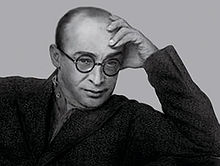Moisei Ginzburg
| Moisei Yakovlevich Ginzburg | |
|---|---|

Moisei Ginzburg in 1920
|
|
| Born | 4 June [O.S. 23 May] 1892 Minsk |
| Died | 7 January 1946 (aged 53) Moscow |
| Nationality | Soviet |
| Occupation | Architect |
| Buildings | Narkomfin Building, 1929 |
Moisei Yakovlevich Ginzburg (Belarusian: Майсей Якаўлевіч Гінзбург, Russian: Моисей Яковлевич Гинзбург; 4 June [O.S. 23 May] 1892, Minsk – 7 January 1946, Moscow) was a Soviet constructivist architect, best known for his 1929 Narkomfin Building in Moscow.
Ginzburg was born in Minsk into a Jewish architect's family. He graduated from Milano Academy (1914) and Riga Polytechnical Institute (1917). During Russian Civil War he lived in the Crimea, relocating to Moscow in 1921. There, he joined the faculty of VKhUTEMAS and the Institute of Civil Engineers (which eventually merged with Moscow State Technical University).
The founder of the OSA Group (Organisation of Contemporary Architects), which had links with Vladimir Mayakovsky and Osip Brik's LEF Group, he published the book Style and Epoch in 1924, an influential work of architectural theory with similarities to Le Corbusier's Vers une architecture. It was effectively the manifesto of Constructivist Architecture, a style which combined an interest in advanced technology and engineering with socialist ideals. The OSA experimented with forms of Communal apartments to provide for the new Communist way of life. Its magazine SA (Sovremennaya Arkhitektura, or Contemporary Architecture) featured discussions of city planning and communal living, as well as the futuristic projects of Ivan Leonidov. The group was dissolved in the early 1930s into an 'All-Union Association of Architects', along with the competing Modernist group ASNOVA, led by Nikolai Ladovsky, and the proto-Stalinist VOPRA.
...
Wikipedia
